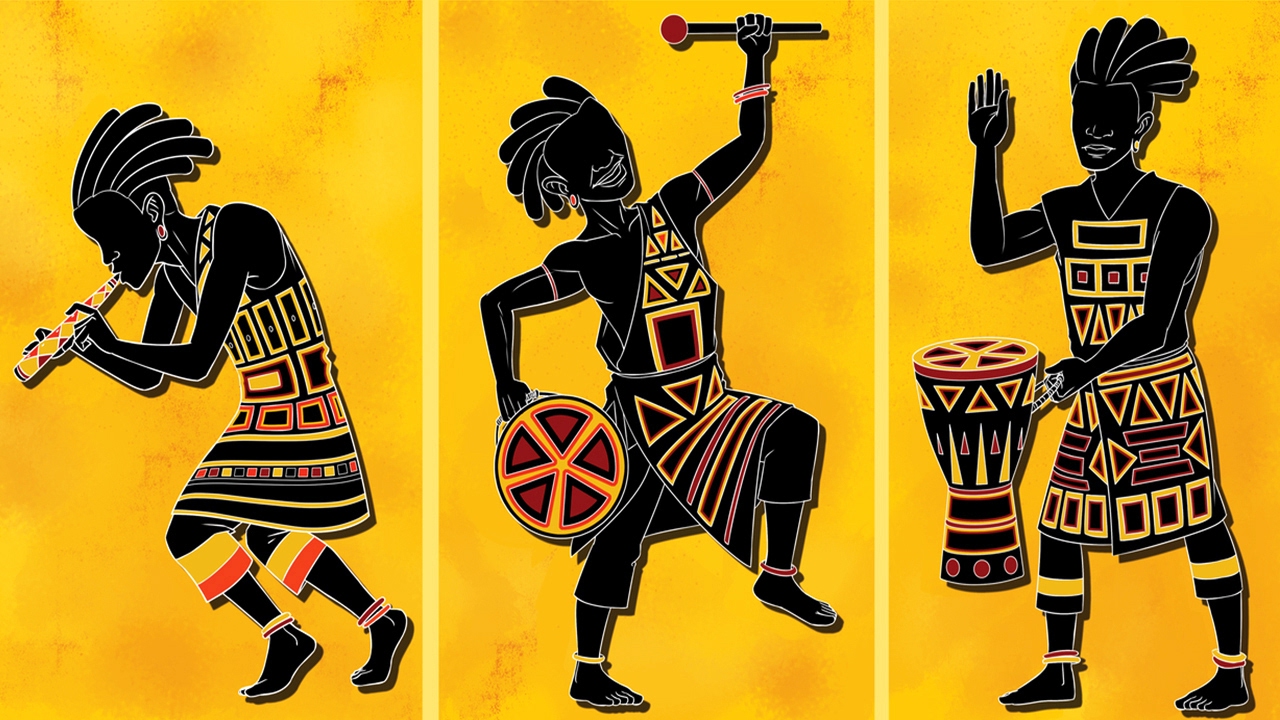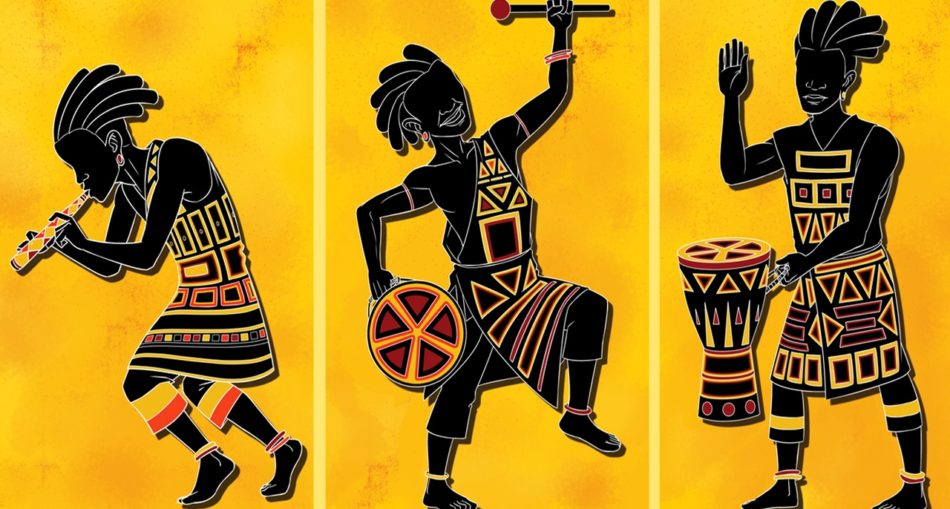Dance is a common form of expression in the Guyanese culture and those of the world. African influence, especially in dance, is reflected in Guyana’s multicultural society. In Guyana, Africans use the art of dance to commemorate important social, religious, traditional and ritual events, in their culture. African dance is used in the form of religious worship, storytelling and even in entertainment. While there are few dances like the Cumfa, many African traditions revolve around dance, a key component in their culture. In Queh Queh, a tradition indigenous to African weddings in Guyana, dance is one of its important rituals. It is also the main, defining factor in Soriee, the celebration of Emancipation in Guyana. Dance is an important part of the African culture in Guyana and is embedded in the history of our country. Read on the learn more about the traditional dances that make up the cultural aspect of Guyana’s African heritage.

African Dancers – Photo by: By Shoushy Kojayan – Own work, CC BY-SA 4.0, https://commons.wikimedia.org/w/index.php?curid=64102685
What is Cumfa?
Cumfa or Kumfa is an African, possession dance, native to West Africa. The Cumfa ceremony and dance originated from the worshipping of a king on the Congo River, known as King O’Cumfa. It is believed that the African ancestors of the slaves, worshipped King O’Cumfa for days and night on the riverside of the Congo River. Even the dance, Cumfa can be said to be named after him.
Cumfa was brought to Guyana by the African slaves and was practised in the 1930s in villages like Charlestown, La Penitence, Albouystown, Linden, Buxton and Victoria. This dance is said to initiate spirit possession in humans, called forth by the rhythmically beating of African drums. participants of the dance do abnormal and extreme actions like pushing woods set on fire into their mouth, celebrating on broken bottles and even jumping into trenches. Quite astonishingly, after the Cumfa dance has ended, the participants are unharmed and as no memory of the events of the dance.
Interesting Tip
- The Ndjukas of Suriname also know of the Cumfa dance.
Features of the Cumfa
- Barefoot Dancing – Before the Cumfa dance begins, broken bottles are scattered on the ground.
- Fire in Mouths – Pieces of wood were often lit afire during the dance. The lighted fire was thrust into the mouths of the dancers.
- Trench Diving – In the midst of this traditional African dance, the tension builds and slowly reaches the climax. As this happens, the dancers would plunge into trenches in ecstasy, whether they could swim or not.
- Possession of spectators – Not unlike worshippers on the Kali mandir, the spectators would often be possessed by the spirits summoned by the Cumfa Dance. This would cause them to stagger around the area, out of their minds. Sometimes they would but their heads into the ground, perhaps in worship?
What is Queh Queh?
The Queh Queh is a nuptial ritual held on the eve of a traditional African Wedding in Guyana. Queh Queh is also known kwe ke, kakalay and mayan in different parts of Guyana. This African ritual originated in Guyana and has evolved in the African based communities. Unlike the other imported traditions like obeah and Cumfa, the Queh Queh is native to Guyana and is a major part of the African culture in Guyana. The main component of Queh Queh is dance, through which moral behaviour and chastity are taught in an ancient and cultural way.
Features of the Queh Queh Dance
- Dance Rhythms – The rhythm of the Queh Queh dance is created by the pounding of feet on the ground. This footwork is an African characteristic that is common in typical African dance movements.
- Musical Instrument – While drums are used in some villages, others use the true drum, their voice. It is believed that the voice is the drum, the most common musical instrument.
- Tutor – While the dancers too are singers, there is a lead singer, typically the spiritual leader of the ceremony that guides the Queh Queh dance. This person is normally called the tutor or chantwelle and stands apart from the rest of the participants.
- Formation – The Queh Queh dancers form a circle and as the singing begins, the move in an anti-clockwise direction, another feature Queh Queh dance shares with other African traditions.
What is Soriee?
Soiree is the celebration of the Emancipation of slaves in Guyana. Like the Queh Queh, or most parts of the African culture, dance is a key factor. This ceremony is a mixture of the African religion, drumming chanting, and shanto dancing, used to evoke the spirits of the African ancestors. In shanto dancing, persons move to the beat of the Guyanese shanto music, a mixture of calypso and mento. A popular part of the Soiree celebration in the Square Dance.
Features of the Square Dance
- Grouping – Persons form themselves into groups of four and dance to the beat of African drums and flute.
- Switching Partners – There are usually about twenty (20) groups and in which the partners are interchanged. The new sounds of a drum initiated a different type of dance.
African Dance in Guyana
African dance is a dominant aspect of their culture, present in many social, religious and traditional ceremonies. Their dance has been integrated into Guyanese history and its people. Proof of this is the Soiree, and its dances, which can only be seen on Emancipation Day and The Cumfa dance is still practised in some African-populated communities in Guyana like Linden, Buxton and Victoria. In addition, Queh Queh remains an integral part of our Guyanese African heritage and wedding rituals. However, with modernization traditions are fading and African dance is not an exception to this. In some cases, practitioners refuse to share their knowledge with others as they are regarded as ancestral secrets and are practised in secret societies. It is not very surprising that they are not very welcoming to outsiders. Perhaps it stems from the want of protecting this aspect of their cultural heritage from the colonist. There have been a few attempts to revive traditional African dance, and modern choreography is added to the mix for performances and shows. While the revival of African dances like the Soiree hasn’t seen much progress, there is yet hope the African dance will not completely disappear.
Article References
- https://www.oas.org/children/folclore/Guyana.html
- https://www.youtube.com/watch?v=QNxphGjKAnM
- http://guyanachronicle.com/2012/05/12/in-honour-of-the-people-that-came
- https://www.stabroeknews.com/2013/08/04/sunday/arts-on-sunday/african-spiritual-beliefs/
- http://www.guyanaundersiege.com/Cultural/African%20heritage%20GT.htm
- https://raquelbahadoorsingh.wordpress.com/cumfa/
- https://www.stabroeknews.com/2016/07/31/sunday/arts-on-sunday/what-is-african-dance/
- http://wongnageda.blogspot.com/
- http://guyanachronicle.com/2018/07/29/let-the-soiree-live-on-keeping-the-age-old-african-celebration-alive
- https://en.wikipedia.org/wiki/Mento








1 Comment
Pingback: When last did you attend a good old Queh-Queh?